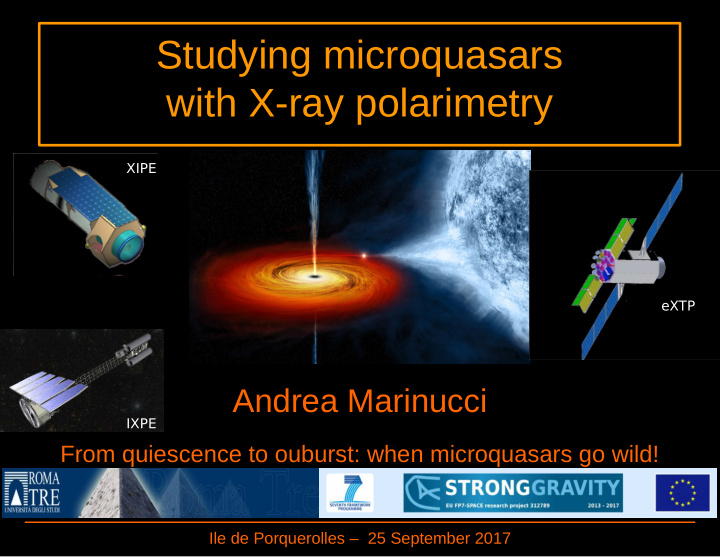



Studying microquasars with X-ray polarimetry XIPE eXTP Andrea Marinucci IXPE From quiescence to ouburst: when microquasars go wild! Ile de Porquerolles – 25 September 2017
Outline - Introduction - Polarimetry and microquasars: ● Coronal geometry ● The role of the jet ● The BH spin - Future instruments Andrea Marinucci (Roma Tre)
Introduction - polarization measurements At the beginning of X-ray astronomy, polarimeters were flown aboard rockets and aboard the OSO-8 and ARIEL-5 satellites. The introduction of X-ray optics, while producing a dramatic improvement in sensitivity, removed the need OSO-8 to rotate the satellite. Therefore, polarimetry based on the classical techniques, Bragg diffraction and Thomson scattering (which require rotation), became seriously mismatched with imaging and spectroscopy. In the last 10 years, with the development of sensors based on the photoelectric effect (Costa+01), polarimetry has been again considered as a realistic option, either for large telescopes with swappable instrumentation or for dedicated small missions. Ariel-5 Andrea Marinucci (Roma Tre)
Introduction - polarization measurements The only positive detection was the polarization of the Crab Nebula (Weisskopf+78) and two significant upper limits were obtained on Cyg X-1 (Weisskopf+77) and Sco X-1 (Weisskopf+78), plus many other upper limits of modest significance (Hughes+84). Weisskopf+78 Instrument dependent Andrea Marinucci (Roma Tre)
Introduction - microquasars Zhang+13 How can we use X-ray polarimetry to study such astrophysical systems? Done+07 Andrea Marinucci (Roma Tre)
Introduction - microquasars The role of the jet The coronal geometry The BH spin Andrea Marinucci (Roma Tre)
The coronal geometry (hard state) kT e d =n dx e kn Assumptions and advantages: Tamborra+, in prep. 1. Shakura-Sunyaev neutral accretion disk 2. Extended coronae 3. Single photon approach 4. Full special relativity included 5. Polarization signal (!) 7/13 Andrea Marinucci (Roma Tre)
The coronal geometry (hard state) Tamborra+, in prep. Stokes parameters: I is proportional to the intensity of the polarized component Q is related to the angle of polarization Andrea Marinucci (Roma Tre)
The coronal geometry (hard state) Tamborra+, in prep. I f the emission is due to Comptonization of the disc thermal photons in a hot corona, polarimetry can constrain the geometry of the corona Andrea Marinucci (Roma Tre)
The role of the jet (hard state) z= 0.5 z= 0 McNamara+09 Coronal emission is predicted to be less than 10% Much larger polarization degrees are expected for jet emission, independently of the details of the jet structure Andrea Marinucci (Roma Tre)
The BH spin (soft state) In accreting Galactic black hole systems, X-ray polarimetry can provide a technique to measure the spin of the black hole, in addition to the three methods employed so far GRO J1655-40: QPO: a = J/Jmax = 0.290±0.003 Continuum: a = J/Jmax = 0.7±0.1 Iron line: a = J/Jmax > 0.95 Andrea Marinucci (Roma Tre)
The BH spin (soft state) Gravitational bending modifies the light geodesics causing a rotation of the plane of polarization, stronger the field larger the rotation: the polarization angle rotates with respect to the Newtonian value The effect increases with decreasing radii, i.e. with increasing temperature, i.e. with increasing photon energy rotation of the polarization angle with energy Connors+80 Andrea Marinucci (Roma Tre)
The BH spin (soft state) Harder photons comes from inner region of the accretion disk and then are more affected; The effect is stronger for a Kerr BH, because the disk gets closer to the compact source Courtesy: Michal Dovciak Andrea Marinucci (Roma Tre)
The BH spin (soft state) 200 ks IXPE observation of GRS1915+105 Harder photons comes from inner region of the accretion disk and then are more affected; The effect is stronger for a Kerr BH, because the disk gets closer to the compact source (adapted from Dovciak+09) Andrea Marinucci (Roma Tre)
Future instruments The photoelectric The photoelectric polarimeter polarimeter Real modulation curve derived from the Residual modulation for unpolarized photons. measurement of the emission direction of the photoelectron. Andrea Marinucci (Roma Tre)
Future instruments - IXPE IXPE 1.8 % MDP for 2x10 -10 erg/s cm 2 Polarisation sensitivity (10 mCrab) in 300 ks (Imaging X-ray Polarimetry Explorer) (CBE) Spurious polarization <0.3 % Selected by NASA (SMEX) for a launch Number of Telescopes 3 in Nov. 2020 Angular resolution 28’’ (CBE) Field of View 12.9x12.9 arcmin 2 P.I.: Martin Weisskopf (MSFC) Focal Length 4 meters Total Shell length 600 mm It will re-open the X-ray polarimetry Range Shell Diameter 24 shells, 272-162 mm window! Range of thickness 0.16-0.26 mm Effective area at 3 keV 854 cm 2 (three telescopes) Spectral resolution 16% @ 5.9 keV (point source) Resolution <8 μs Timing Accuracy 150 μs Operational phase 2 yr Energy range 2-8 keV Background (req) 5x10 -3 c/s/cm2/keV/det Sky coverage, Orbit 50 %, 540 (0 o ) Andrea Marinucci (Roma Tre)
Future instruments - XIPE XIPE (X-ray Imaging Polarimetry Explorer). Selected by ESA (M4) for phase A study. Final selection: July 2017 – Launch: 2025. Lead Scientist: Paolo Soffitta (IAPS/INAF, Italy) A scaled-up version of IXPE (larger area, longer duration, more flexible operations). From the exploratory to the mature phase Andrea Marinucci (Roma Tre)
Future instruments - eXTP eXTP (enhanced X-ray Timing and Polarimetry Mission). Proposed to CAS; selected in 2011 as one of 8 “background missions”. Phase A study in 2011-14. P.I: Shuang-Nan Zhang (Tsinghua Univ.). An international consortium (China + many european countries). Launch: 2025 ? Simultaneous spectroscopic, timing and polarimetric observations Focal plane imaging polarimeter: 4 optics with 5.25m FL Imaging, PSF 20 arcsec HPD Gas Pixel Detector: single photon, <100µs Energy band: 2-10 keV Energy resolution: 20% FWHM @6 keV T otal efgective area: 900 cm 2 @2 keV (includes QE) Andrea Marinucci (Roma Tre)
Recommend
More recommend